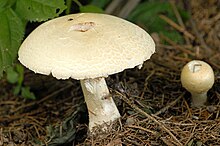Agaricus excellens
| Agaricus excellens | |
|---|---|

| |
| Scientific classification | |
| Kingdom: | Fungi |
| Division: | Basidiomycota |
| Class: | Agaricomycetes |
| Order: | Agaricales |
| Family: | Agaricaceae |
| Genus: | Agaricus |
| Species: | A. excellens
|
| Binomial name | |
| Agaricus excellens F.H.Møller (1952)
| |
| Synonyms[1][2] | |
| |
| Agaricus excellens | |
|---|---|
| gills on hymenium | |
| cap is convex or flat | |
| hymenium is free | |
| stipe has a ring | |
| spore print is purple-black | |
| ecology is saprotrophic | |
| edibility: edible | |
Agaricus excellens (French: Psaliote Excellente, German: Riesen-Egerling[3]) is a rare mushroom in the genus Agaricus. It is native to Europe.
Description[]

A specimen of A. excellens.
- Cap: It is whitish yellow in color. Spread over 10–15 cm across, it is convex and a bit flat, yellowing slightly at the center especially with age, and densely covered in minute fibrous scales of the same colour. It feels silky.[1][4]
- Stem / Stipe: Stem is 100–140 x 20–35mm, white in color; the ring is thick and white. The underside is scaly or fibrillar.[1][4]
- Gills: The gills are pale-pink and free.[1][4]
- Spores and microscopic features : Spore print is purplish black. Spores are elliptic, measuring 9–12 x 5–7µ.[1][4]
- Flesh and smell: The cap flesh is reddish-white. It tastes sweet and a bit like mushroom, smells slightly of aniseed and almond.[1][4]
Habitat[]
It is commonly found in coniferous and deciduous areas and grows during late autumn to summer amongst grass in open woodland, especially spruce. It is typically found at an altitude of 0 to 914 meters (0 to 3000 feet).[3]
See also[]
- List of Agaricus species
References[]
- ^ a b c d e f "Agaricus excellens". Rogers Mushrooms. Archived from the original on 2010-12-30.
- ^ "Agaricus excellens (F.H. Møller) F.H. Møller 1952". MycoBank. Retrieved 30 October 2016.
- ^ a b "Agaricus excellens". Zipcode Zoo. Archived from the original on 2012-10-09.
- ^ a b c d e "Agaricus excellens". MushLook. Archived from the original on April 2, 2012.
Categories:
- Agaricus
- Fungi described in 1952
- Fungi of Europe